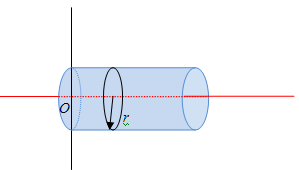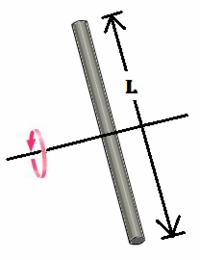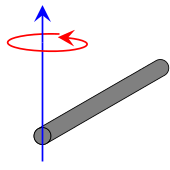Moment of Inertia for a cylinder: Difference between revisions
No edit summary |
No edit summary |
||
| Line 32: | Line 32: | ||
If the axis of rotation has the same direction as the second equation, that is perpendicular to the length, but is at the end of the rod, just touching one of the circular caps, then the equation would be: | If the axis of rotation has the same direction as the second equation, that is perpendicular to the length, but is at the end of the rod, just touching one of the circular caps, then the equation would be: | ||
<math> I = \frac{1}{4}*M*R^2 + \frac{1}{3}*M*L^2 </math> | <math> I = \frac{1}{4}*M*R^2 + \frac{1}{3}*M*L^2 </math> | ||
As can be seen here: | |||
[[File:axis end rod.png|200px|center]] | |||
==Examples== | ==Examples== | ||
Revision as of 19:18, 30 November 2015
This page discusses the moment of inertia specifically in the case of a cylinder or rod.
Written by Jack Corelli
A Brief Overview
See The Moments of Inertia for a more general explanation of moments of inertia.
The moment of inertia of an object relates the mass of the object, the distance between the center of mass and the shape of rotation. In a ring, or uniform loop, the center of mass is exactly at the center of the ring, and the moment of inertia can be found by approximating the exterior ring as a single line, akin to a circle.
Governing Equations
In its simplest form, the moment of inertia can be found for a simple, constant density and shape rod by the equation:
[math]\displaystyle{ I = \frac{1}{2}*M*R^2 }[/math] Where I is the moment of inertia, M is the mass of the object being rotated and R is the radius of the rod. This describes the moment of inertia calculated when a rod is spun about its center axis.
As can be seen here:

If the axis of rotation is no longer the center of the cylinder or rod, the equations for moment of inertia change distinctly. At the center of a rod, with the axis of rotation perpendicular to the length:
[math]\displaystyle{ I = \frac{1}{4}*M*R^2 + \frac{1}{12}*M*L^2 }[/math]
As can be seen here:

If the axis of rotation has the same direction as the second equation, that is perpendicular to the length, but is at the end of the rod, just touching one of the circular caps, then the equation would be: [math]\displaystyle{ I = \frac{1}{4}*M*R^2 + \frac{1}{3}*M*L^2 }[/math] As can be seen here:

Examples
Be sure to show all steps in your solution and include diagrams whenever possible
Simple
Middling
Difficult
Connectedness
- How is this topic connected to something that you are interested in?
- How is it connected to your major?
- Is there an interesting industrial application?
History
Put this idea in historical context. Give the reader the Who, What, When, Where, and Why.
See also
Are there related topics or categories in this wiki resource for the curious reader to explore? How does this topic fit into that context?
Further reading
Books, Articles or other print media on this topic
External links
Internet resources on this topic
References
This section contains the the references you used while writing this page